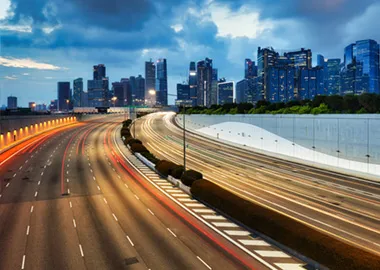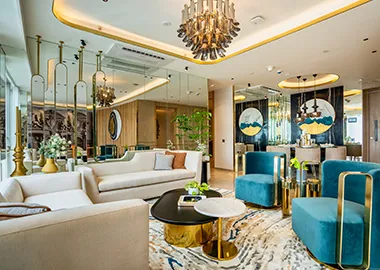Future Of Sustainable Cities: How To Make Urban Homes Sustainable?
By lodha
September 28, 2023Context: Amory Lovins, the visionary behind sustainable living, Cofounder and Chairman Emeritus, RMI along with Abhishek Lodha, MD & CEO, Lodha, was interviewed with CNBC-TV18 in the wake of the RMI-Lodha Sustainability Conclave. Here's the interview.
As the world faces the growing challenges of climate change and environmental degradation, the real estate sector has emerged as a crucial player in promoting sustainability by integrating energy efficiency, water conservation, eco-friendly materials, smart city solutions and social considerations. The sector has worked hard to create environmentally responsible and socially inclusive spaces. The Lodha group has set up a Net Zero Urban Accelerator at Palava City, to accelerate India's transition towards net-zero.
Sonia: Joining us now is Abhishek Lodha, the CEO of the Lodha group and Amory Lovins, the co-founder and chairman emeritus of the Rocky Mountain Institute.
Thank you so much for joining us on the show and it is indeed a crucial time to implement policies towards sustainability, just because of how challenging things have become on the climate change front but I would like to begin with you,
Q: Abhishek, what is the future of sustainability in real estate?
Abhishek: Thanks for having us here today and it's a very important topic for the world and for India. The built environment emits almost one-third of the embedded carbon in the world and since buildings have a lifespan of 80 to 100 years, what we do today matters all the way to the end of the century. We believe that the Indian real estate industry should and can lead the energy and carbon transition in India and we believe that with help from leading technical and industry experts such as the Rocky Mountain Institute, which is a globally recognized body in this field, this transition can happen in a seamless manner without really impacting the productivity or the economics of the industry. We as a company are committed to being net-zero on carbon by 2035 and hope to get there well before that and we also believe that in general there is a lot of room for the industry to do and make sure that not only the buildings but also the people who live and work there can contribute in a positive manner to the environment.
Q: Mr. Amory, you have been doing immense work in this direction for a very long time now, so I want to understand from you, how one creates a sustainable real estate environment. What are the different options that one can look at?
Amory Lovins: Well, whether it's on the scale of building a neighborhood, a city, a nation if you design whole systems for multiple benefits, not piles of isolated parts for single benefits, then those parts work together and not against each other. Part of our pleasure in supporting Lodha group's pioneering work in this field is to advance the whole industry and to show that it is practical and profitable, so it's a good value proposition and it makes the people in the buildings more happy, healthy, and productive.
Q: What are the big technology trends that you are noticing and are also working at?
Abhishek: There is such a huge variety of innovation that is going on in this area because it is such an important part of global economies as well as of the sustainable direction that the world is embarking on. The things that we more regularly use include a vast amount of renewable power. RMI runs the global cooling price where they look for Solutions that can reduce the impact of the negative emissions that come from air conditioning spaces and how you can achieve that while maintaining the comfort of people, so there's a lot of new and innovative technology which is reducing CFC emissions and yet keeping spaces cool with a combination of the active machines plus also passive design like shading, right orientation. You have sewage treatment plants that will give you 80-85% recovery of water by cycling the water over seven times reducing the ratio because it means that effectively you can reduce the new water requirement of a development by five to seven times. I would say 60-70% of the solutions are already available, they just have to be indigenized for use in a low-cost and low-income country like India. People have to be trained on how to operate them. I think education and awareness is key.
Q: Coming back to the technology Trends, what or where else do you think our focus should be where both education and awareness are required?
Amory: Everything we do in buildings can be made much more efficient. When we moved into our own house in 1982, our household electric bill was 400 rupees a month for 372 square meters, of which over half is an indoor farm in a research center. The house itself was not so big, but we didn't even need a heating or cooling system in a climate that went up to minus 44 degrees. It's a Himalayan climate and inside we're ripening our 81st passive solar banana crop where we are using a traditional six thousand-year-old Northern Chinese passive solar design. Similarly, across all of India, there are traditional designs that will keep you feeling 11 or 12 degrees cooler just by building the thing right, and then if you add a good ceiling fan, that's 16 to 19 degrees cooler with little or no extra cost. I have a cooking system that uses two and a half to four times less electricity than the supposedly most efficient induction cooktop, there's a Swiss heat pump that when used can give you six to fifteen units of hot water for one unit of electricity and there are even experimental methods recently demonstrated in Singapore for staying comfortable at 32 degrees in the shade.
Q: So there are multiple options, yet you know in a country like India, it's still a very under-penetrated concept. Why do you think that is? What is the reason that a lot of cities have not adopted these sustainability methods just yet?
Abhishek: First and foremost, it's about education and awareness. In India, there is an innate respect for Mother Nature. However, I think in Modern India, we need to make people aware of what they can do themselves in their own day-to-day lives or in the places that they live or work in to make a positive contribution to Mother Nature and future generations. I think that effort and awareness is an ongoing things and just by doing one ad campaign or by giving one interview, everybody is not going to be able to comprehend it. With ongoing effort, people will realise that sustainability can be lower cost or at least not extra cost and also lower operating cost because you would use less gas or less electricity and you're leaving a better environment which is a win-win situation. So I think the biggest challenge is your awareness and education and as it picks up, we will see more focus on this area.
Q: Lodha has the Net Zero Urban Accelerator. What is the game plan for the next 5 - 10 years? What are you looking to do with the entire initiative?
Abhishek: Amory has kindly agreed to partner with us which has given us a huge head start because it allows us to use the best in class global knowledge and indigenize it by trying it in the Indian context. So at Palava which now has 1,75,000 people living and has everything from golf courses to cricket grounds to schools to malls etc., we can try all of these solutions and see what needs to be tweaked for the Indian context. Our culture is different, our electricity supply may be slightly different, whatever it may be, we indigenize it and then once we have something stable, we publish that research, that information freely for everyone to use across the board, across India. As the level of educational awareness picks up, people know what needs to be done next, so the idea here is to create information that will be used across the Lodha portfolio but more importantly, we want to freely share it with everyone so every individual, every developer, every corporate have access to what needs to be done. Everything is out there, and it's up to you.
Amory: it's such a wonderful contribution for such a leader in that market to share it with all its competitors. We'll compete on other stuff but this is what we need, especially in a country where we're building so much and it's much easier to build it right than fix it later. This sort of public-spirited business leadership I think is what's going to give India a remarkable competitive advantage because there is such an immense depth in the talent pool. With such levels of entrepreneurship and ambition, you really have everything you need if you put all the bits together.
Q: This is the need of the hour and I think the finance Minister's Focus as well. She has spoken about green projects in the budget this time too, so you know the government is going in that direction as well but I wanted you to talk about the details of the five specific focus areas of this accelerator.
Abhishek: The accelerator has five areas where we are focusing on and think the impact could be the highest. Without getting into too much technical detail on each of these, the idea here is how we can make sure that the resource consumption whether of water electricity or carbon can be moderated while not reducing anything which gives people a good quality of life. So that really is the trade-off that is being made. You may say clean mobility means let's have electric vehicles yes you can by all means have electric vehicles but then do you have renewable power to power those electric vehicles or are you using fossil fuel power; that's one part of the equation. The next and bigger part of the equation is can do a passive design to have wide footpaths that are also shaded so people don't need any electricity to get around because they will walk themselves or they will cycle. This is the kind of comprehensive approach that is necessary. EV is a part of it but it's not the whole thing and that's the kind of approach that we are taking which makes passive as well as active solutions a part of how we move forward.
Amory: and even better is to be already where you want to be so you didn't go somewhere else. If we design our settlements so that the places people live, worship, and play are all within walking distance, then we don't need vehicles.
Q: I want to talk about how the flagship Palava City project has been serving as a living laboratory for testing and implementing a lot of these sustainable solutions and what the future of that looks like.
Abhishek: At Palava, now we have about 1,75,000 people living, over 40,000 families. It has tens of kilometers of roads, golf courses, cricket grounds other sports amenities, schools, hospitals, and everything that a modern city of a small scale can have. The key is how to make sure that the need to move around is operated and optimized and made walkable. So we planned Palava under the 5-10-15 principle, wherein what you need on a daily basis is within a 5-minute walking distance, and on a weekly basis is between 10-15 minutes of walking distance. That is the kind of model in which it has been built and then wide roads, wide footpaths, sheltered spaces, and green open spaces. More than 60% of Palava is open and green, so those are the building blocks because when people live in an environment that is built in this manner, ultimately their health and well-being prosper. We have a 100% water recycling wherein all the water that is consumed goes into the sewage treatment plants, recycled use for you know flushing for landscaping, and like I said, you get five-seven cycles of water consumption out of one inlet of fresh water. We use the best-in-class air-conditioning solutions with the lowest CFC emissions. We also use passive solutions which make sure that with the right size window, the right kind of shading, and the right orientation of the building, you need less air conditioning and therefore people's own operating costs come down.
Q: Does a lot of these sustainability options come at a higher cost? Could you elaborate on how the revenue model works?
Abhishek: There are some things which are a higher cost but generally no. I think it's a matter of attention to detail and of course, we play at a large scale so we get the benefit of our volume but generally, I don't think that there is a huge increase in cost even if you are a regular developer. The total cost of doing a highly sustainable project would not be more than five to eight percent of the normal cost. Now you have to look at lifetime costs, not only operating costs because if you employ all these sustainable solutions, your operating costs are much lower because you use less electricity you use less water you use less cooling so automatically your monthly bills are lower, your maintenance costs are lower. The biggest thing is this world that you're going to leave for your children, your future generations. If it is even one percent better off because you did a little bit extra that's worth doing, it's all worth it.
Amory: The costs are often low, sometimes even negative. It used to be 10 to 30 times of premium for a zero energy house in Europe, and now it's zero plus or minus two percent depending on how good you are. So the experience has brought it right down and of course, there are also other ways to encourage this. You could pay your Architects and engineers for what they save, not for what they spend or the local government could say if you have a zero-energy building, you go to the head of the queue for approvals. That costs the government nothing but the time saved is gold to a developer.
Q: what are the tenets of sustainability, if a policymaker was listening to you, what would be the 4-5 top things they could take away?
Amory: Whole System Design, Passive design, drawing also on traditional techniques, good spatial techniques to avoid the unwanted running time, designing with nature, and using the best techniques that will give better service at a lower cost for longer durations.
You may also like



 Enquire
Enquire
 Call
Call
 chat
chat
 Search
Search





